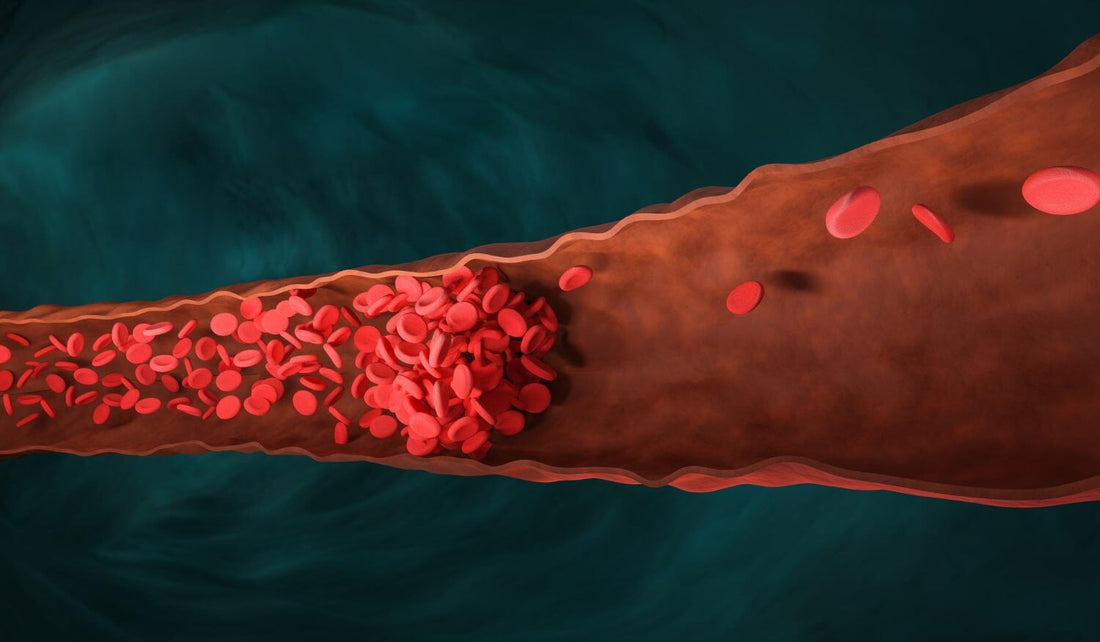What is DVT?
Deep Vein Thrombosis (DVT) is a medical condition where blood clots develop in the body's deep veins, typically in the lower legs or thighs. Symptoms typically include swelling, pain, tenderness, and warm skin in the affected area. While DVT can occur in anyone, the risk increases following surgery, trauma, or due to factors like obesity and smoking. A serious complication of DVT is the risk of a clot traveling to the lungs, causing a pulmonary embolism, particularly post-surgery. Doctors often recommend DVT compression socks to mitigate these risks and improve blood circulation. These socks are designed to reduce swelling and enhance blood flow, which is crucial in managing and preventing DVT.
What causes DVT?
The risk factors for Deep Vein Thrombosis (DVT) encompass a wide range of genetic, lifestyle, and medical conditions:
- Genetics: Conditions like Factor V Leiden mutation alter blood clotting mechanisms.
- Cancer and Chemotherapy: Certain types of cancer and chemotherapy treatments increase clotting risks.
- History of DVT: Personal or family history elevates the likelihood of DVT.
- Reduced Blood Flow: Due to injuries, surgeries, or prolonged immobility.
- Prolonged Inactivity: Long travels or recovery periods post-surgery can impede blood circulation.
- Pregnancy and Postpartum: These conditions change the body's circulation dynamics.
- Age Factor: Individuals over 40 are particularly at a higher risk.
- Obesity: Excess weight puts additional pressure on veins.
- Autoimmune Diseases: Conditions like lupus or inflammatory bowel disease contribute to increased risk.
- Tobacco Use: Smoking adversely affects blood flow and clotting.
- Varicose Veins: These can lead to circulation issues.
- Hormonal Factors: Use of birth control pills or hormone therapy.
- Medical Devices: Such as central venous catheters or pacemakers.
- COVID-19: Recent infection can influence clot formation.
- Heart Failure: Compromises blood flow and increases DVT risk.
Additionally, in some cases, DVT may occur without any identifiable risk factors, a condition termed unprovoked venous thromboembolism (VTE).
DVT symptoms
Deep Vein Thrombosis (DVT) is a significant health concern, caused by the formation of blood clots in deep veins, typically in the legs. Key symptoms of DVT include:
- Swelling: One of the most common signs, usually occurring in one leg.
- Pain or Tenderness: Often experienced in the leg, the pain might start in the calf and feel like cramping or soreness.
- Red or Discolored Skin: The affected area might appear reddish or have a noticeable color change.
- Warmth: The skin around the painful area may feel warmer than surrounding areas.
It's crucial to note that DVT can sometimes occur without noticeable symptoms. Understanding these symptoms is vital for early detection, and treatment is essential in preventing serious complications such as pulmonary embolism. If you suspect DVT, it's important to seek medical attention promptly.

Complications of deep vein thrombosis
- Pulmonary Embolism (PE): A serious condition where a blood clot from a vein lodges in the lungs. Symptoms of PE include sudden shortness of breath, chest pain during inhalation or coughing, rapid breathing, a fast heartbeat, fainting, and coughing up blood. Immediate medical attention is crucial.
- Postphlebitic Syndrome: This occurs due to vein damage from the clot, leading to reduced blood flow. Symptoms include persistent leg pain, swelling, skin color changes, and ulcers.
- Treatment Complications: Blood thinners, commonly used to treat DVT, can cause bleeding. Regular blood tests are essential to monitor this side effect.
DVT treatment
- Anticoagulant Therapy for DVT: Treatment for Deep Vein Thrombosis (DVT) primarily involves anticoagulants, or blood thinners, which prevent blood clots from growing or moving. These medications don't dissolve existing clots but can help the body naturally reduce them over time. There are various types of anticoagulants, such as warfarin, heparin, and oral Xa inhibitors, and the duration of treatment varies based on individual circumstances.
- Compression Socks: Compression socks are another key element in DVT management. They apply graduated pressure to the legs, aiding blood flow and reducing swelling caused by damaged vein valves or blood flow blockages. Wearing these socks daily can significantly improve symptoms.
- Surgical Interventions for DVT: In cases where medication is not suitable or effective, inserting an inferior vena cava (IVC) filter might be necessary. This filter, placed in the body's largest vein via a catheter, helps prevent large blood clots from reaching the lungs.
DVT prevention
To effectively reduce the risk of Deep Vein Thrombosis (DVT), a combination of medical adherence, lifestyle changes, and specific preventive measures are recommended:
- Medication: Diligently follow the medication plan prescribed by your healthcare provider.
- Regular Medical Follow-Ups: Keep up with appointments for monitoring and adjusting your treatment as necessary.
- Lifestyle Modifications: Adopt a healthier diet, increase physical activity, and abstain from tobacco.
- Compression Socks: Using DVT compression socks, especially during prolonged periods of immobility, to aid blood circulation and prevent clot formation.
- Active Leg Movement: Regularly exercise your calf muscles during extended sitting, such as on long flights or drives.
- Prompt Mobilization: Aim to move around as soon as possible after surgery or during recovery from illness to minimize the chances of developing a clot.
- Postoperative Care: Follow healthcare recommendations on using medications or compression stockings after surgery to lower the risk of clots.
-
Consistent Healthcare Consultation: Stay in regular contact with your healthcare provider and heed their advice to manage the clot formation risk effectively.

Try Viasox Compression Socks for DVT Management
Incorporating compression socks for deep vein thrombosis into daily wear can be highly beneficial. Viasox offers graduated compression socks designed to improve circulation and reduce clot risks in DVT patients. Beyond their medical function, these socks come in various styles and colors, providing an opportunity to personalize healthcare routines. Viasox emphasizes effectiveness and aesthetic appeal in its products, ensuring users don't have to compromise on style for health benefits. Our customer service team can also assist with any queries or concerns.





